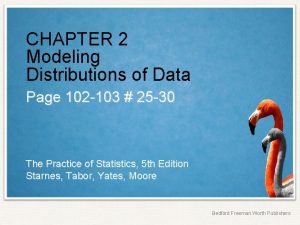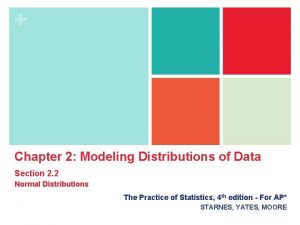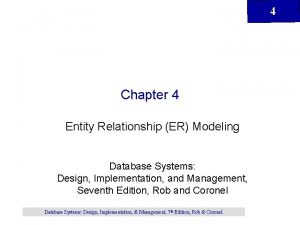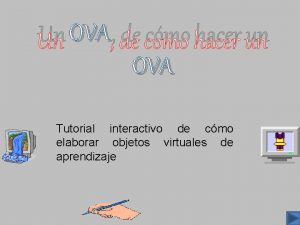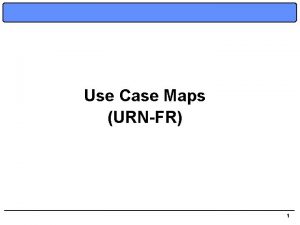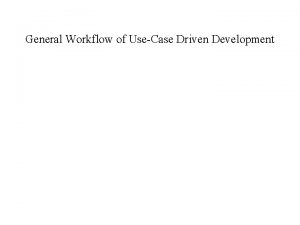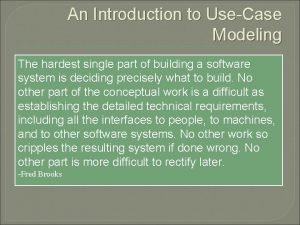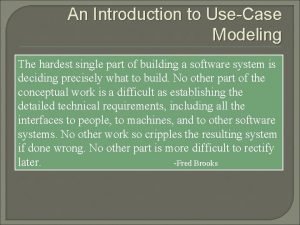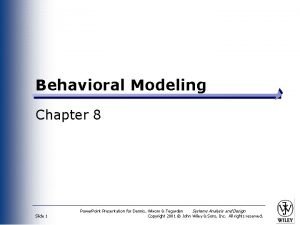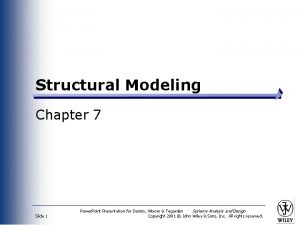UseCase Modeling Chapter 6 Slide 1 Power Point

























- Slides: 25

Use-Case Modeling Chapter 6 Slide 1 Power. Point Presentation for Dennis, Wixom & Tegardem Systems Analysis and Design Copyright 2001 © John Wiley & Sons, Inc. All rights reserved.

Key Ideas A use case illustrates the activities that are performed by users of a system. Use cases are logical models -- they describe the activities of a system without specifying how the activities are implemented. 2 Power. Point Presentation for Dennis, Wixom & Tegardem Systems Analysis and Design Copyright 2001 © John Wiley & Sons, Inc. All rights reserved.

USE-CASE DESCRIPTIONS Slide 3 Power. Point Presentation for Dennis, Wixom & Tegardem Systems Analysis and Design Copyright 2001 © John Wiley & Sons, Inc. All rights reserved.

What are Use-Case Descriptions? Describe basic functions of the system What the user can do How the system responds Use cases are building blocks for continued design activities. 4 Power. Point Presentation for Dennis, Wixom & Tegardem Systems Analysis and Design Copyright 2001 © John Wiley & Sons, Inc. All rights reserved.

How Are Use-Cases Created? Two steps: Write text-based case descriptions Translate descriptions into diagrams Describes one and only one function, but may have multiple paths. Developed working with users for content. 5 Power. Point Presentation for Dennis, Wixom & Tegardem Systems Analysis and Design Copyright 2001 © John Wiley & Sons, Inc. All rights reserved.

Types of Use-Cases Overview versus detail Essential versus real 6 Power. Point Presentation for Dennis, Wixom & Tegardem Systems Analysis and Design Copyright 2001 © John Wiley & Sons, Inc. All rights reserved.

Elements of a Use-Case Description Use Case Name: ID: Primary Actor: Use Case Type: Importance Level: Stakeholders and Interests: Brief Description: Trigger: Relationships: (Association, Include, Extend, Generalization) Normal Flow of Events: Subflows: Alternate/Exceptional Flows: 7 Power. Point Presentation for Dennis, Wixom & Tegardem Systems Analysis and Design Copyright 2001 © John Wiley & Sons, Inc. All rights reserved.

Guidelines for Creating Use-Case Descriptions Write each step in “SVDPI” form Clarify initiator and receivers of action Write from independent observer perspective Write at same level of abstraction Ensure a sensible set of steps Apply KISS principle liberally Write repeating instructions after the set of steps to be repeated. 8 Power. Point Presentation for Dennis, Wixom & Tegardem Systems Analysis and Design Copyright 2001 © John Wiley & Sons, Inc. All rights reserved.

Your Turn How would you make requirements gathering (interviews, questionnaires, observation, and document analysis) more effective by knowing that eventually you will be creating use-case descriptions and diagrams? 9 Power. Point Presentation for Dennis, Wixom & Tegardem Systems Analysis and Design Copyright 2001 © John Wiley & Sons, Inc. All rights reserved.

USE-CASE DIAGRAMS Slide 10 Power. Point Presentation for Dennis, Wixom & Tegardem Systems Analysis and Design Copyright 2001 © John Wiley & Sons, Inc. All rights reserved.

Syntax for Use-Case Diagram 11 Power. Point Presentation for Dennis, Wixom & Tegardem Systems Analysis and Design Copyright 2001 © John Wiley & Sons, Inc. All rights reserved.

The Use-Case Diagram for Appointment System 12 Power. Point Presentation for Dennis, Wixom & Tegardem Systems Analysis and Design Copyright 2001 © John Wiley & Sons, Inc. All rights reserved.

Use-Case Diagram with Specialized Actor 13 Power. Point Presentation for Dennis, Wixom & Tegardem Systems Analysis and Design Copyright 2001 © John Wiley & Sons, Inc. All rights reserved.

Extend and Include Relationships 14 Power. Point Presentation for Dennis, Wixom & Tegardem Systems Analysis and Design Copyright 2001 © John Wiley & Sons, Inc. All rights reserved.

CREATING USE-CASE DESCRIPTIONS AND USECASE DIAGRAMS Slide 15 Power. Point Presentation for Dennis, Wixom & Tegardem Systems Analysis and Design Copyright 2001 © John Wiley & Sons, Inc. All rights reserved.

Major Steps in Writing Use. Cases Identify the major use-cases Expand the major use-case Confirm the major use-cases Create the use-case diagram 16 Power. Point Presentation for Dennis, Wixom & Tegardem Systems Analysis and Design Copyright 2001 © John Wiley & Sons, Inc. All rights reserved.

Identifying the Major Use. Cases Identify the system’s boundaries List the primary actors List the goals of each primary actor Identify and write the major usecases Carefully review use-cases 17 Power. Point Presentation for Dennis, Wixom & Tegardem Systems Analysis and Design Copyright 2001 © John Wiley & Sons, Inc. All rights reserved.

Expand the Major Use. Cases Choose one major use-case to expand Fill in details on the use-case template Fill in the steps of the normal flow of events Normalize the size of each step Describe alternate or exceptional flows Simplify and organize as necessary 18 Power. Point Presentation for Dennis, Wixom & Tegardem Systems Analysis and Design Copyright 2001 © John Wiley & Sons, Inc. All rights reserved.

Confirm the Major Use Cases Review the current set Consider semantics and syntax Helpful to involve the users Iterate the entire set of steps until all use cases are defined 19 Power. Point Presentation for Dennis, Wixom & Tegardem Systems Analysis and Design Copyright 2001 © John Wiley & Sons, Inc. All rights reserved.

Create the Use-Case Diagram Start with system boundary Place elements in order to be easy to read Place actors on the diagram Conclude by connecting actors to use cases by lines 20 Power. Point Presentation for Dennis, Wixom & Tegardem Systems Analysis and Design Copyright 2001 © John Wiley & Sons, Inc. All rights reserved.

Selecting the Appropriate Techniques Interviews JAD Type of Information As-Is Improve. To-Be Depth of Information High Breadth of Information Low Integration of Info. Low Questionnaires Observation As-Is Medium Low Medium High Low Low User Medium Involvement High Low Low Cost Low. Medium 21 Medium As-Is Improve. To-Be Document Analysis Low Low. Medium Power. Point Presentation for Dennis, Wixom & Tegardem Systems Analysis and Design Copyright 2001 © John Wiley & Sons, Inc. All rights reserved.

Identify the major use-cases Expand the major use-case Confirm the major use-cases Create the use-case diagram

Your Turn Create a set of use cases for campus housing. Consider the steps in registering for campus housing, in being assigned to a particular unit, to being matched with roommates, to moving in. 23 Power. Point Presentation for Dennis, Wixom & Tegardem Systems Analysis and Design Copyright 2001 © John Wiley & Sons, Inc. All rights reserved.

Summary Use-case descriptions are the basis for further analysis and design. They are created based on 7 guidelines and 13 steps. Use-case diagrams present a graphical overview of the main functionality of a system. 24 Power. Point Presentation for Dennis, Wixom & Tegardem Systems Analysis and Design Copyright 2001 © John Wiley & Sons, Inc. All rights reserved.

Expanding the Domain Additional resources regarding use-cases and many other object-oriented development topics can be found at: http: //www. omg. org 25 Power. Point Presentation for Dennis, Wixom & Tegardem Systems Analysis and Design Copyright 2001 © John Wiley & Sons, Inc. All rights reserved.
 Atm usecase diagram
Atm usecase diagram Atm usecase diagram
Atm usecase diagram Use case realization
Use case realization Heel toe polka steps
Heel toe polka steps Role modeling theory
Role modeling theory Dimensional modeling vs relational modeling
Dimensional modeling vs relational modeling Free power point slide
Free power point slide The real lesson 21
The real lesson 21 Power bi power point
Power bi power point Point point power
Point point power Factoring a binomial
Factoring a binomial Chapter 2 modeling distributions of data
Chapter 2 modeling distributions of data Chapter 2 modeling distributions of data
Chapter 2 modeling distributions of data Bridge entity erd
Bridge entity erd Osu power slide
Osu power slide Solar power satellites and microwave power transmission
Solar power satellites and microwave power transmission Actual power
Actual power Flex28024a
Flex28024a What is dispersive power of grating
What is dispersive power of grating Power of a power property
Power of a power property Chain rule範例
Chain rule範例 Power angle curve in power system stability
Power angle curve in power system stability Power delivered vs power absorbed
Power delivered vs power absorbed Evangelio del domingo en power point
Evangelio del domingo en power point Ejemplos de ova en power point
Ejemplos de ova en power point La boutique del powerpoint
La boutique del powerpoint











